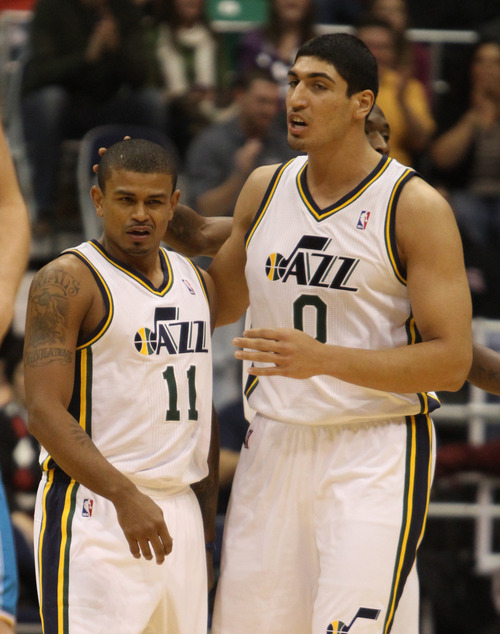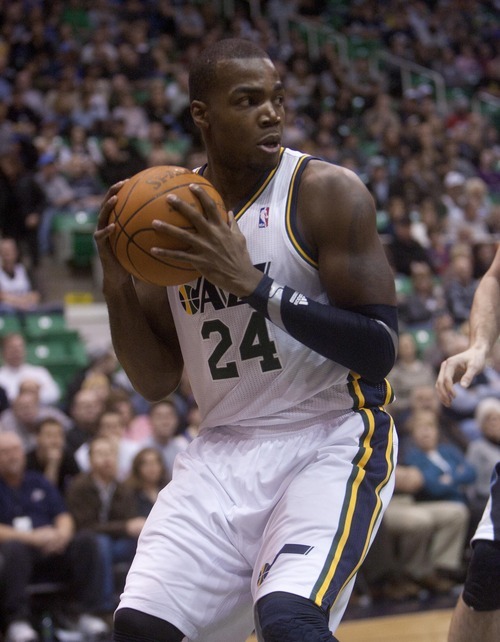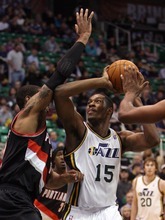This is an archived article that was published on sltrib.com in 2012, and information in the article may be outdated. It is provided only for personal research purposes and may not be reprinted.
How did the Jazz get here?
Three games away from the playoffs. No downfall without Deron Williams. The return of tough, postseason-worthy basketball despite Jerry Sloan's departure.
Devin Harris' midseason turnaround was crucial. Gordon Hayward's evolution has been key. Coach Tyrone Corbin, a deep bench, young athletes blending with proven veterans and the ability to weather a lockout-shortened season better than most have all played parts.
But nothing compares with the Jazz's Big Four.
Al Jefferson, Paul Millsap, Derrick Favors and Enes Kanter have provided Utah with a powerful — at times invaluable — frontcourt attack. All are 27 or younger. All have played in at least 58 of 63 games. United, they've given the Jazz one of the most imposing front lines in the league.
Utah ranks second in average points in the paint (49.7), third in rebounds (43.9) and fourth in blocks (5.8). As the NBA's gone small, the Jazz have become big. And if Utah pushes its way into the playoffs, it'll be because of its front four.
"It's one of the things we've relied on all year long. It's probably been the most consistent part of what we've done … and that's why we're so focused on going inside," Corbin said. "Teams can't stop [our] guys. There aren't that many bigs, and they're not used to playing over and over and over again."
At best, Utah's been 48 minutes of unrelenting power. Jefferson's team-leading 19.4 average points are often built off midrange shots; Millsap's ballhandling has allowed him to effectively play small forward. But it's the endless punch of the Jazz's Big Four that ultimately sets Utah apart.
Opponents have begun doubling either Jefferson or Millsap, while Big Al has been fronted as teams attempt to keep the ball out of his soft hands. Even when the veteran duo leave the court, the beastly Favors and bull-like Kanter — with only 39 years of combined age and 2.5 of experience — are ready to pound.
Jefferson and Millsap have spent 14 seasons in the league. Neither has played on a team this stacked in the paint. Both acknowledged having four legitimate bigs on one club is a luxury that long ago went out of style.
"We had some good big lineups in the past, but it's normally been a three-man rotation," Millsap said. "Now, it's more of a four and it's more in depth."
Jefferson went even deeper.
"Big Turkey and Derrick, in my opinion, are going to be starters in this league and some big-time players in this league. … With me and Paul, [Millsap] can play the 3 and 4. So, yeah, we are going to be a lot of trouble for teams if we get in [the playoffs]," he said.
Utah could've been even deeper if center Mehmet Okur hadn't been traded to New Jersey just before the season. But Jazz general manager Kevin O'Connor knew exactly what he was doing when he dealt the aging, injury-plagued Okur.
The move also offered a crucial hint about Utah's future.
Millsap and Jefferson will play under expiring contracts in 2012-13. They're Utah's best players, but they'll also command major money as free agents. Millsap's open to negotiating an extension, and talks can officially begin in July. Jefferson will make $15 million next season, and should again command top dollar with statistics comparable to Orlando's Dwight Howard and the Los Angeles Lakers' Andrew Bynum.
With Favors and Kanter nowhere close to their ceilings, Utah's biggest question moving forward is whether it can keep its Big Four intact.
O'Connor said everything from the 2012 NBA Draft and free agency to Kanter's summer development and Utah's use of the $10 million trade exception acquired for Okur will affect future decisions.
Jefferson knows what the Jazz have is unique.
He's also aware it might not last.
"Kevin got a tough job, because he got two promising young bigs that's going to be great in this league," he said. "I'd love to be here and be a part of it. But I'll just let that happen when it happen. … It's a good problem. There's going to be some big-time decisions made. But it's just an honor to be on the team with these guys, man."
Twitter: @tribjazz
facebook.com/tribjazz —
By the numbers
Pts Reb Blk Min Gms
Al Jefferson 19.4 9.6 1.6 34.2 58
Paul Millsap 16.4 8.7 0.8 32.5 62
Derrick Favors 8.5 6.4 0.9 20.9 62
Enes Kanter 4.4 4.2 0.3 13 63 —
Big numbers
Stat Jazz Avg NBA rank (out of 30)
Reb 43.9 3
Pts in paint 49.7 2
Blocks 5.8 4
Off Reb 13 3
Pct of pts from 2-pointers 68.5 3 —
Magic vs. Jazz
P At EnergySolutions Arena
Tipoff • Saturday, 8:30 p.m.
TV • ROOT Sports, ESPN
Radio • 1320 AM, 1600 AM, 98.7 FM
Records • Magic 36-26, Jazz 33-30
Last meeting • Jazz, 117-105 (Dec. 10, 2010)
About the Magic • Center Dwight Howard (back) is out for the season, while forward Hedo Turkoglu (face) is inactive. … Orlando has lost three of five and eight of 12. … Glen Davis scored 27 points on 12-of-16 shooting during a 102-98 road loss to Boston on Wednesday.
About the Jazz • Gordon Hayward's averaging 18.3 points, 4.3 rebounds and 3.5 assists while shooting 51.3 percent from the field and 52.5 percent behind the 3-point line during 10 games in April. … Utah closes its season by playing three games at home. The Jazz are 22-8 in Salt Lake City.







